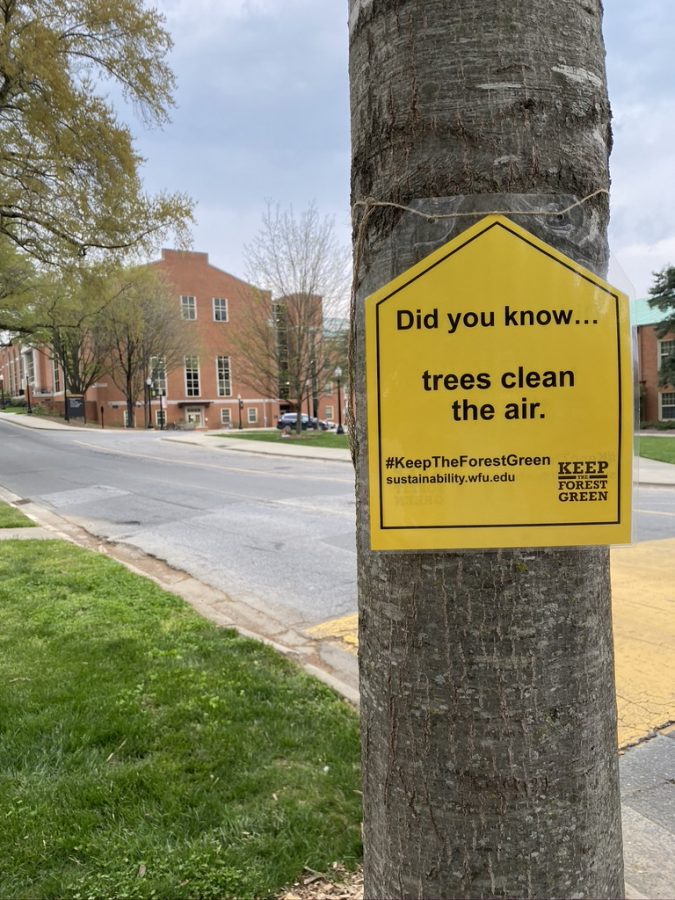“Tree tags” make appearance on campus
The tags are designed to help Wake Forest students realize the important role trees play
April 8, 2021
In addition to the blooming colors of spring popping up on campus, yellow tree tags have begun appearing as well.
These tags are a part of an annual Office of Sustainability campaign to raise awareness in the campus community regarding the importance of trees in the buildup to the university’s Arbor Day celebration.
“The goal is to raise awareness of some of the many ways trees contribute to the quality of our daily lives,” University Arborist Jim Mussetter said. “When someone looks at a tree, I hope they see more than just a shade opportunity in July. When someone hangs a hammock between two trees, I hope they think about the silent sentinels cleaning the air they breathe and the water they drink.”
Since 1993, some 2,400 trees have been planted on the university’s Reynolda campus as a part of a wider initiative to bring more trees to Wake Forest. Many of them were planted and are maintained by the university’s arboriculture team. The team’s efforts culminate in an annual Arbor Day celebration, wherein the team interacts with the campus community to share their knowledge and promote tree planting.
Thanks in part to the efforts of the arboriculture team, Wake Forest was recognized as a U.S.A. Tree Campus in 2012.
The efforts of the Office of Sustainability center largely on taking action against climate change and educating students on sustainable behaviors. In advertising the favorable effects of trees on the campus environment, students gain a better understanding of the role that trees play in mitigating climate change.
“I would say that having been a part of sustainability efforts here at Wake [Forest] for two semesters now has shown that the biggest challenges are getting people to care and reaching our audience,” said freshman Mia Pagnani, a member of the Office of Sustainability’s student leadership group (SLG.). “[As a result,] we have to get creative with everything we do to catch people’s attention and make an impact.”
Many students across campus have taken notice of the recent additions to the trees, which fulfill the campaign’s intended impact on sustainability efforts at Wake Forest. The office is hopeful that the appreciation of trees will extend far beyond Wake Forest’s campus and inspire students to treat the environment in a more conscientious and respectful manner.
“Social norming is very powerful,” said Brian Cohen, assistant director of sustainability engagement at the Office of Sustainability. “Simply helping to foster an appreciation for our trees can go a long way. While the trees on campus are well cared for, that’s not always the case elsewhere. By creating an environment in which trees are discussed and appreciated [on a community-wide basis,] people will be more likely to act accordingly and take those values with them outside of Wake.”
When it comes to sustainable behaviors, no concrete change can be made without campus-wide collaboration. As such, the tree campaign has brought needed attention to an office that has struggled to appeal to students.
“The campus community notices the tree tags, so I know they are thinking about the information” Mussetter said. “There has been more engagement from faculty, students and campus planning staff.”
Because many on campus seem unfazed by the dangers posed by climate change, the tree tag campaign is important in inspiring students to take action.
“Whether that’s engaging in tree planting, tree health maintenance, forest conservation efforts or something else,” Cohen said. “[These initiatives] help people realize the interconnectedness of the natural world and can make them more likely to engage in other efforts.”
As of late, many students are choosing to get involved with some of the office’s initiatives and doing their part.
“I want to get more involved in sustainability on campus, and I thought the yellow tags were a great start,” freshman Ava Hirshberg said. “It makes me want to find out what I can do to help our local environment.”
“It’s a fine line to walk between scaring students and keeping their attention while introducing the truth of our environment’s needs,” Pagniani said.
“Even though the yellow signs on the trees are not my doing,” she continued. “I see that they are a product of both of these things, and while I’ve seen students noticing them, I can only hope that they have a prolonged impact.”













